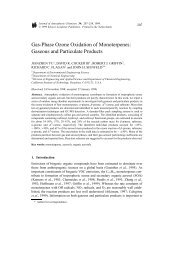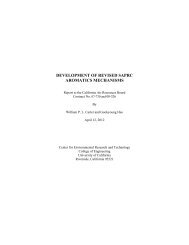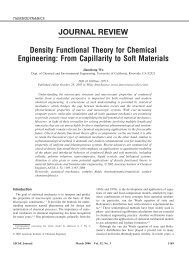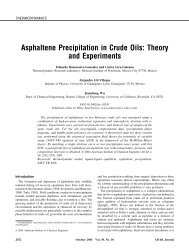A modified fundamental measure theory for spherical particles in ...
A modified fundamental measure theory for spherical particles in ...
A modified fundamental measure theory for spherical particles in ...
Create successful ePaper yourself
Turn your PDF publications into a flip-book with our unique Google optimized e-Paper software.
J. Chem. Phys., Vol. 119, No. 4, 22 July 2003 Spherical <strong>particles</strong> <strong>in</strong> microchannels<br />
2289<br />
systems, the <strong>fundamental</strong> <strong>measure</strong> <strong>theory</strong> FMT by Rosenfeld<br />
probably gives the most accurate structural and thermodynamic<br />
properties of <strong>in</strong>homogeneous hard-sphere<br />
fluids. 18,19 This <strong>theory</strong> assumes that the excess <strong>in</strong>tr<strong>in</strong>sic<br />
Helmholtz energy can be expressed <strong>in</strong> terms of weighted<br />
densities that take <strong>in</strong>to account the geometric feature of a<br />
<strong>spherical</strong> particle. Because the weight functions are <strong>in</strong>dependent<br />
of density distributions, FMT is numerically more convenient<br />
to implement than most other nonlocal densityfunctional<br />
theories. Recently, we have re<strong>for</strong>mulated the<br />
<strong>fundamental</strong>-<strong>measure</strong> <strong>theory</strong> based on the Boublik–<br />
Mansoori–Carnahan–Starl<strong>in</strong>g–Leland BMCSL equation of<br />
state. 20–22 This modification leads to improvements on both<br />
density distributions and the adsorption isotherms of <strong>spherical</strong><br />
<strong>particles</strong>, especially at high pack<strong>in</strong>g densities. 23<br />
In this work, we apply the NVT ensemble Monte Carlo<br />
simulation and the improved <strong>fundamental</strong>-<strong>measure</strong> <strong>theory</strong> to<br />
<strong>in</strong>vestigat<strong>in</strong>g the structures and adsorption isotherms of neutral<br />
hard spheres and associat<strong>in</strong>g hard spheres <strong>in</strong> microchannels<br />
of different geometries. For comparison with the prediction<br />
of the DFT, the chemical potentials <strong>in</strong> Monte Carlo<br />
simulation are calculated us<strong>in</strong>g a <strong>modified</strong> Widom’s <strong>in</strong>sertion<br />
method. 23 Because the excess chemical potential is extrapolated<br />
from those <strong>for</strong> smaller test<strong>in</strong>g hard spheres, this simulation<br />
method is applicable to systems with high pack<strong>in</strong>g<br />
densities.<br />
II. NVT SIMULATION OF CONFINED HARD SPHERES<br />
We consider N hard spheres of uni<strong>for</strong>m diameter conf<strong>in</strong>ed<br />
<strong>in</strong> a rectangular channel of length L(l1) <strong>in</strong> the x<br />
direction and H(h1) <strong>in</strong> the y direction. Periodic<br />
boundary conditions are imposed <strong>in</strong> the z direction. The geometry<br />
of the rectangular channel is fixed at l14 and h<br />
9 and the average density of hard spheres with<strong>in</strong> the channel<br />
varies from 3 0.42 to 0.93, all below the freez<strong>in</strong>g<br />
density of hard spheres <strong>in</strong> the bulk. We assume that the microchannel<br />
consists of structureless hard walls with no attraction<br />
to the conf<strong>in</strong>ed <strong>particles</strong>.<br />
The conventional Metropolis algorithm is used <strong>for</strong> generat<strong>in</strong>g<br />
successive configurations with the probability of successful<br />
displacement adjusted to 50%. At each density, the<br />
simulation box conta<strong>in</strong>s 1001 <strong>particles</strong> and the simulation is<br />
run <strong>for</strong> 2.110 8 Monte Carlo step MCS <strong>for</strong> sampl<strong>in</strong>g the<br />
density distributions after about 110 6 MCS per particle <strong>for</strong><br />
equilibrium. The density profiles are recorded with a fixed<br />
b<strong>in</strong> size of 0.025.<br />
Along with the density profiles, the excess chemical potential<br />
of hard spheres is calculated us<strong>in</strong>g a <strong>modified</strong> Widom’s<br />
<strong>in</strong>sertion method proposed by Labik and Smith. 23 In<br />
this method, the excess chemical potential of a large particle<br />
is extrapolated from those <strong>for</strong> a range of smaller <strong>particles</strong>.<br />
Accord<strong>in</strong>g to the scale-particle <strong>theory</strong>, 24 the excess chemical<br />
potential of a hard-sphere fluid can be related to the work to<br />
<strong>in</strong>sert a particle <strong>in</strong>to the system, which is proportional to the<br />
particle volume and surface area. It follows that the excess<br />
chemical potential of a hard test<strong>in</strong>g particle can be represented<br />
as a third-order polynomial of the particle diameter d<br />
approximately<br />
3<br />
e av d/k B T a i d i ,<br />
1<br />
i0<br />
where k B stands <strong>for</strong> the Boltzmann constant and T <strong>for</strong> temperature.<br />
The coefficients a 0 , a 1 , a 2 and a 3 are <strong>in</strong>dependent<br />
of hard-sphere diameter and can be obta<strong>in</strong>ed by fitt<strong>in</strong>g Eq.<br />
1 to the excess chemical potential of smaller <strong>particles</strong> calculated<br />
us<strong>in</strong>g Widom’s <strong>in</strong>sertion method. 17 By extrapolat<strong>in</strong>g<br />
the diameter of the <strong>in</strong>serted particle to the hard sphere diameter<br />
, Eq. 1 allows us to obta<strong>in</strong> the excess chemical potential<br />
of conf<strong>in</strong>ed hard spheres at relatively high densities.<br />
III. DENSITY FUNCTIONAL THEORY FOR HARD<br />
SPHERES AND ASSOCIATING HARD SPHERES<br />
The essential task of a density functional <strong>theory</strong> is to<br />
provide an analytical expression <strong>for</strong> the <strong>in</strong>tr<strong>in</strong>sic Helmholtz<br />
energy F(r) as a functional of the density distribution<br />
r. For a one-component system with a given chemical<br />
potential <strong>in</strong> an external potential V ext (r), the equilibrium<br />
density distribution satisfies the Euler–Lagrange equation<br />
V ext rFr/r.<br />
2<br />
With an expression <strong>for</strong> the <strong>in</strong>tr<strong>in</strong>sic Helmholtz energy<br />
F(r), the density distribution r can be solved from Eq.<br />
2, and subsequently both structural and thermodynamic<br />
properties can be calculated <strong>in</strong> pr<strong>in</strong>ciple.<br />
In this work, we consider neutral and associat<strong>in</strong>g hard<br />
spheres conf<strong>in</strong>ed <strong>in</strong> microchannels. The <strong>in</strong>tr<strong>in</strong>sic Helmholtz<br />
energy <strong>in</strong>cludes an ideal part F id (r) that is known exactly<br />
F id rk B T dr rlnr 3 1,<br />
and an excess part F ex (r) that takes <strong>in</strong>to account the<br />
excluded-volume effect and <strong>in</strong>terparticle associations. In Eq.<br />
3, stands <strong>for</strong> the thermal wavelength of a particle. Conventionally,<br />
it is postulated that the excess <strong>in</strong>tr<strong>in</strong>sic Helmholtz<br />
energy functional can be expressed as<br />
F ex rk B T dr r,<br />
where the excess <strong>in</strong>tr<strong>in</strong>sic Helmholtz energy density r<br />
is a function of r. For the systems considered <strong>in</strong> this work,<br />
r consists of contributions from hard-sphere repulsion<br />
hs and <strong>in</strong>terparticle associations assoc,<br />
r hs r assoc r.<br />
5<br />
In the limit of a uni<strong>for</strong>m fluid, V ext (r)0 and r, the<br />
excess <strong>in</strong>tr<strong>in</strong>sic Helmholtz energy reduces to the conventional<br />
residue Helmholtz energy, and r becomes the<br />
residue Helmholtz energy per unit volume.<br />
We use a <strong>modified</strong> <strong>fundamental</strong>-<strong>measure</strong> <strong>theory</strong> to represent<br />
the excess <strong>in</strong>tr<strong>in</strong>sic Helmholtz energy density due to<br />
hard-sphere collisions. 22 In our previous work, we have<br />
shown that this DFT <strong>theory</strong> provides an accurate description<br />
of density distributions of hard spheres near hard walls and<br />
<strong>in</strong> hard slit pores. In addition, it predicts accurate direct and<br />
pair correlation functions of uni<strong>for</strong>m hard spheres <strong>in</strong>clud<strong>in</strong>g<br />
those <strong>for</strong> highly asymmetric hard-sphere mixtures. As <strong>in</strong> the<br />
orig<strong>in</strong>al <strong>fundamental</strong>-<strong>measure</strong> <strong>theory</strong> proposed by<br />
3<br />
4<br />
Downloaded 14 Jul 2003 to 166.111.35.209. Redistribution subject to AIP license or copyright, see http://ojps.aip.org/jcpo/jcpcr.jsp
















